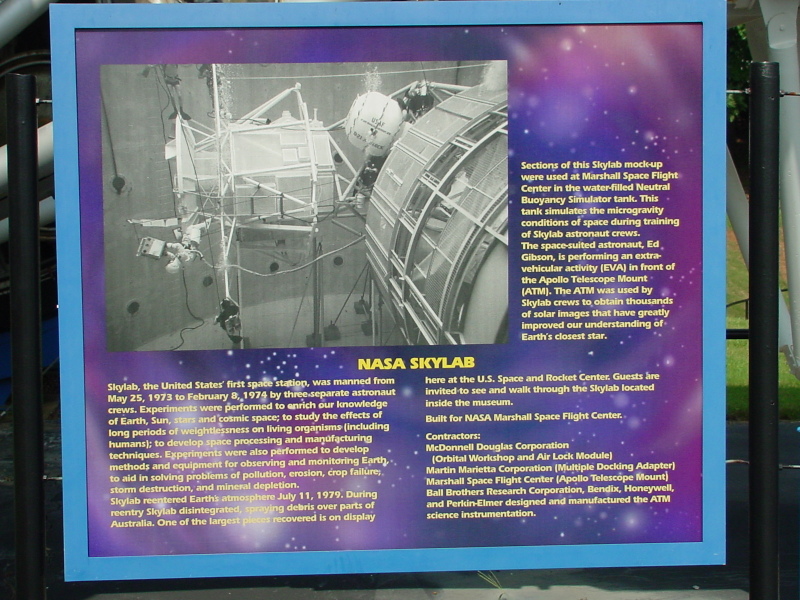| Prev |
heroicrelics.org U.S. Space & Rocket Center Site Index Skylab Mockup Gallery |
Next |
dsc00305.jpg
One of the signs accompanying the Skylab mockup. It reads
NASA Skylab
Skylab, the United States' first space station, was manned from May 25, 1973 to February 8, 1974 by three separate astronaut crews. Experiments were performed to enrich our knowledge of Earth, Sun, stars, and cosmic space; to study the effects of long periods of weightlessness on living organisms (including humans); to develop space processing and manufacturing techniques. Experiments were also performed to develop methods and equipment for observing and monitoring Earth, to aid in solving problems of pollution, erosion, crop failure, storm destruction, and mineral depletion.
Skylab reentered Earth's atmosphere July 11, 1979. During reentry Skylab disintegrated, spraying debris over parts of Australia. One of the largest pieces recovered is on display here at the U.S. Space & Rocket Center. Guests are invited to see and walk through the Skylab located inside the museum.
Built for NASA Marshall Space Flight Center.
Contractors:
- McDonnell Douglas Corporation (Orbital Workshop and Air Lock Module)
- Martin Marietta Corporation (Multiple Docking Adapter)
- Marshall Space Flight Center (Apollo Telescope Mount)
- Ball Brothers Research Corporation, Bendix, Honeywell, and Perkin-Elmer designed and manufactured the ATM science instrumentation.
Sections of this Skylab mockup were used at Marshall Space Flight Center in the water-filled Neutral Buoyancy Simulator tank. This tank simulates the microgravity of conditions of space during training of Skylab astronaut crews. The space-suited astronaut, Ed Gibson, is performing an extra-vehicular activity (EVA) in front of the Apollo Telescope Mount (ATM). The ATM was used by Skylab crews to obtain thousands of solar images that have greatly improved our understanding of Earth's closest star.
The portions of the Skylab mockup which were used in the Neutral Buoyancy Simulator include the Apollo Telescope Mount, Multiple Docking Adapter, and Airlock Module. Historically, the Orbital Workshop mockup was also a component (modified for display at the USSRC) which was used in the NBS. However, the current S-IVB stage (S-IVB-211) was substituted in 1979 when the first (S-IB) stage of SA-211 was placed on display at the Ardmore Welcome Center.
The ATM, when displayed at the USSRC, originally had two "stub" solar panels, but they were removed sometime in the 1990s or early 2000s.
Skylab was actually the United States' only space station. The only other space station which actually flew with which the United States was involved is the ISS, which is an International (rather than U.S.) Space Station.
The sign invites guests to "see and walk through the Skylab located inside the museum." For a time, the 1-G Skylab trainer from MSFC was displayed inside Space Hall in the museum. However, prior to the time of my first visit in 2002, the trainer had been moved outdoors to the bone yard west of the museum. Happily, part of the crew trainer was restored and moved indoors in in 2013, for the 40th anniversary of the launch of the Orbital Workshop.

| Time picture taken | Sat Jul 27 10:00:52 2002 |
| Location picture taken |
Rocket Park U.S. Space & Rocket Center Huntsville, AL |
| Prev |
heroicrelics.org U.S. Space & Rocket Center Site Index Skylab Mockup Gallery |
Next |